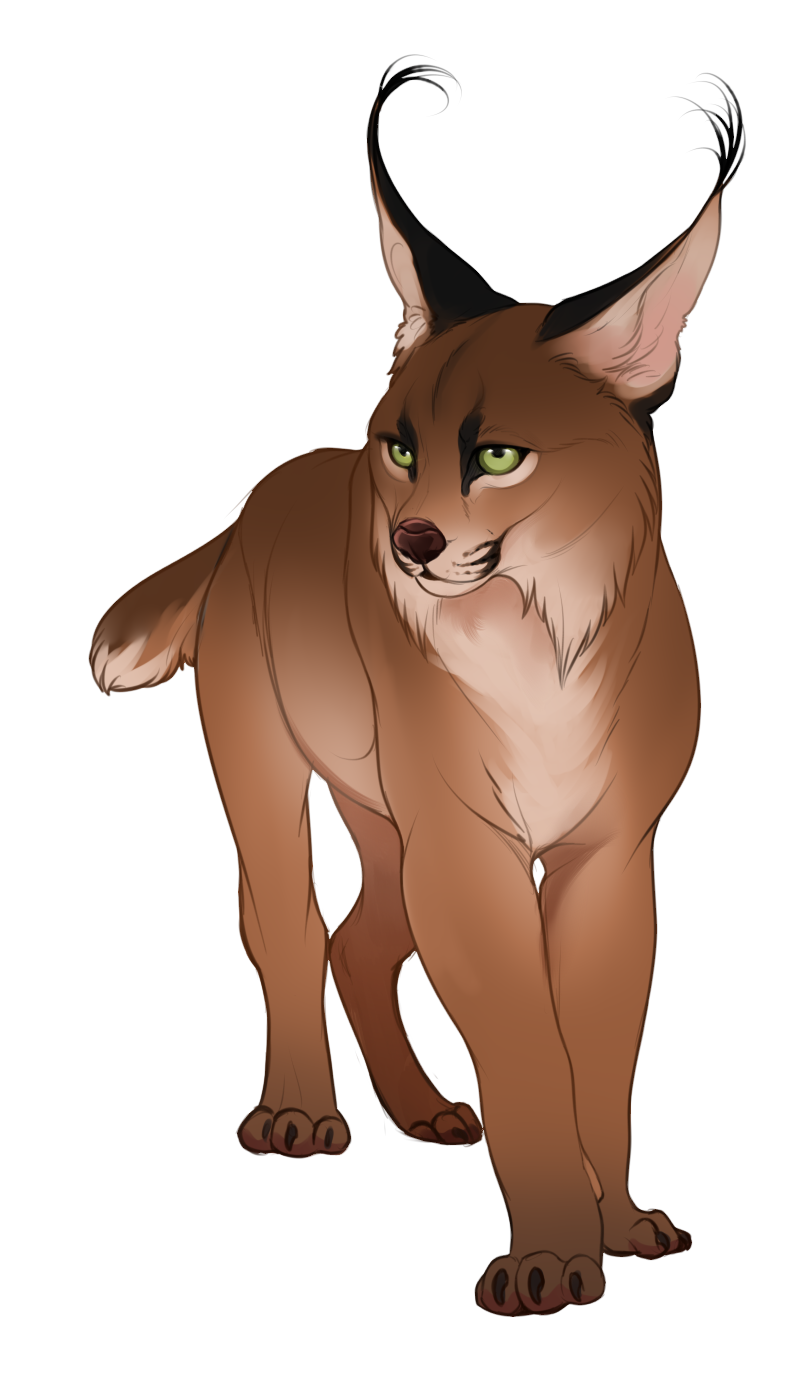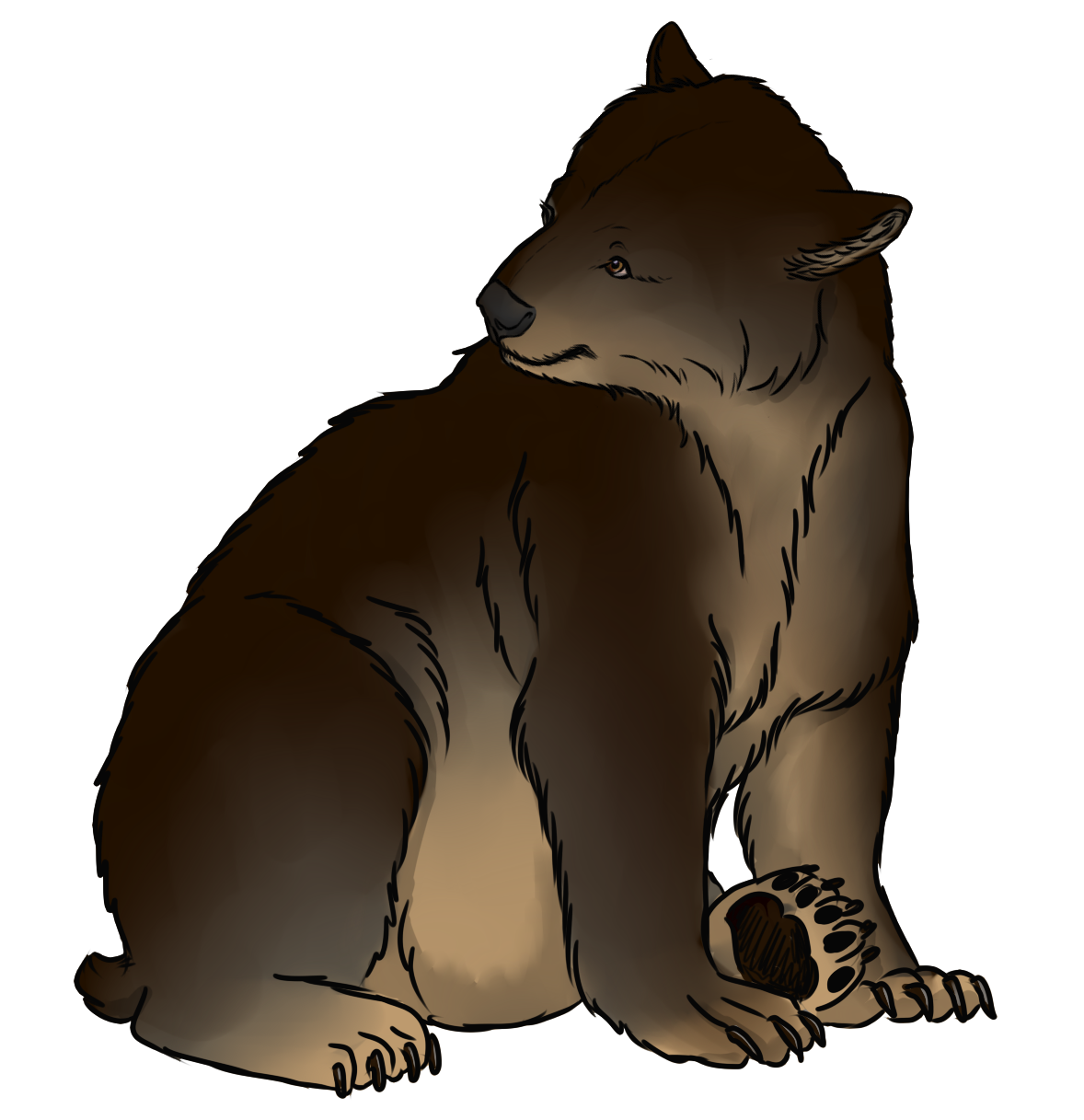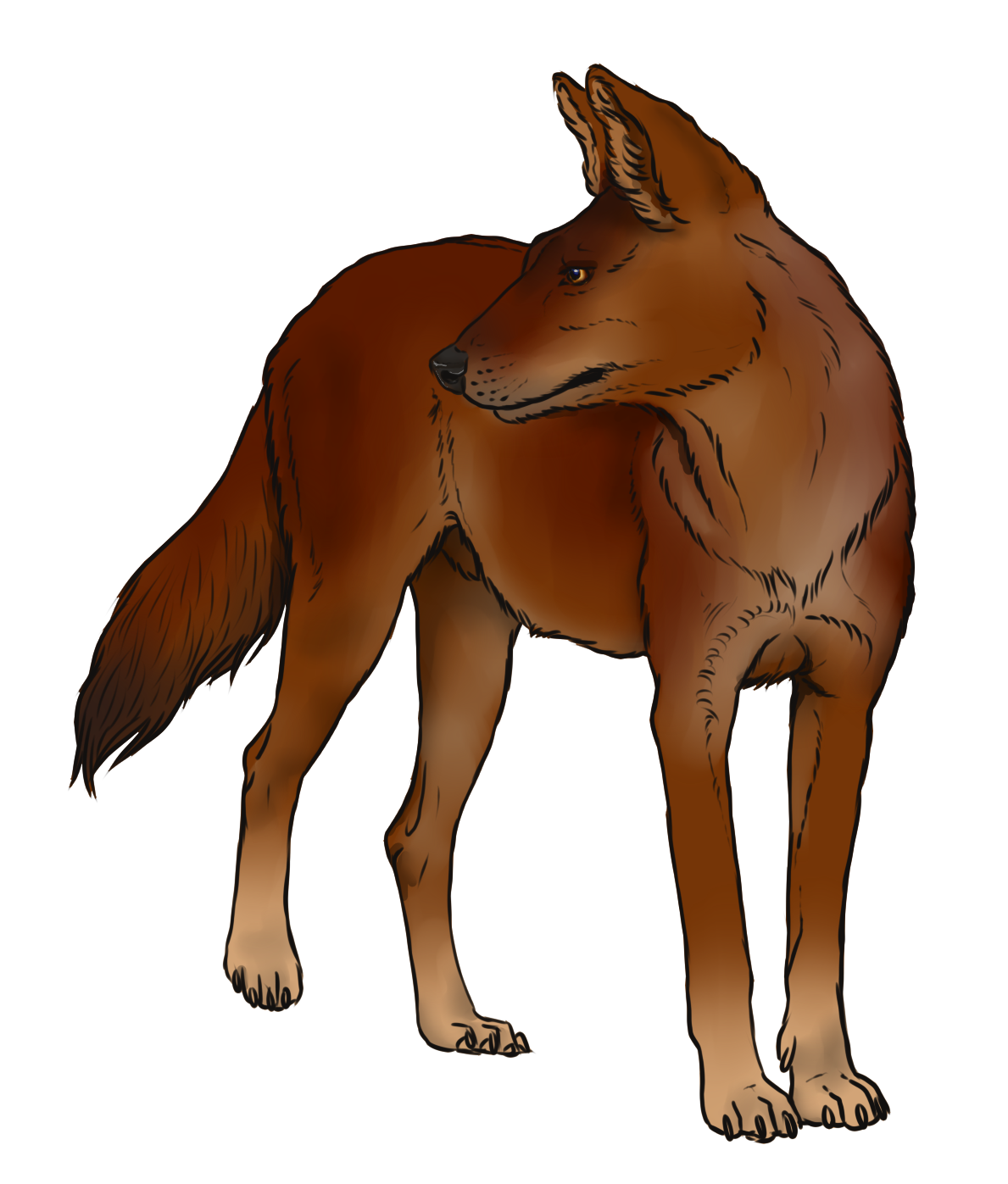Predators of Drabardi Island
text
Ratnavati Catamount
The Ratnavati catamount is quite wide spread over the entire island except the Pesha island. One type that ranges over the eastern part seem to be a bit more robust than the western part, who instead seems a bit more long legged. The differences are not big enough to separate them into different spieces, it seems more to be an adaptation to where they live.
Physical characteristics
The Ratnavati catamount is a slender feline predator characterised by a somewhat robust build, a short face, long black tufts on the ears, tufted cheeks, and semi-long legs. It reaches nearly 60-70 centimetres at the shoulder. In looks one can say it look like a cross between a cougar and a caracal, mimicing much of the later spieces appearance. The catamounts fur color can be divided into two major color morphs, where the most common one is 'red' (chestnut to red-brown) and the more uncommon are known as 'grey' (grey-brown to dark slate). While most of the catamounts coats are plain, some cats can be spotted. Cats in the eastern parts of the island tend to have heavier spotting than those in the western areas, and its a thought that this are an adaptation to the area where they live. The spotting can range from faded tan to black in color, it can also be limited to the belly and inner legs. The later is more common for those in the western parts of the island if they are spotted. Its undersides as well as the areas around the eyes, cheeks, chin, and throat are most often in a tan or creamy color to almost white. Its tail is darker on the top and if the cat is spotted it can be either heavily banded, or lightly banded, ending in a darker or black tip. Melanistic and leucistic individuals occur, but are not common. Catamounts have distinctive black markings on their faces, and some individuals may also have pronounced 'eyebrow' markings. Eye colors can range from pale blue (in lighter coated individuals only), hunter green to yellow-brown.
Biology and behavior
The catamount lack the ability to roar, and instead it will make distinct sounds that for example include whistles, chirps, growls, hisses, and purrs. It is quite secretive and largely solitary by nature, and for the main part active during the night and during twilight, although it isn't uncommon to see it hunt during the day either if it's not too hot. The catamount is quite a successful generalist predator. Even if it have a great sprint, the catamount is typically an ambush predator. It stalks through the brush or tall grass, and it will do a short but powerful sprint, before delivering a powerful leap onto the back of its prey if it's of the large kind, giving it a suffocating neck bite. The catamount is capable of breaking the neck of some of its smaller prey with just a one bite, and its momentum at it's attack can bring a bigger animal to the ground. It's primary food sources of the larger kind are donkeys, but can also go after livestock such as cattle and sheep. It can also hunt species as small as insects and rodents (like mice and rabbits) if it has to. It is adept at climbing, which allows it to evade canine competitors and although it is not strongly associated with water, it can swim quite well. Usually this cat prefers habitats with somewhat dense underbrush and rocky areas for stalking, but can also live in open grassland areas as long as there is some sort of cover and protection for it to hide or seek shade. The catamount is not always the apex predator have been seen to yield both the Ulv and the Drabardi bear. It is an obligate carnivore like many other cats, and that means it needs to feed exclusively on meat to survive. The catamount typically have one litter every two to three years throughout their reproductive lives. Only females are involved in parenting. Female catamounts are fiercely protective of their young (1-5 kits in a litter, usually 2, are born blind) that are completely dependent on their mother at first, and begin to be weaned at around three months of age. As they grow, the young catamounts begin to go out on forays with their mother, first visiting kill sites, and after about six months beginning to hunt small prey on their own.
UPDrabardi bear
This predator mainly live in the north and northeast of the main island, and just like the other major predators it is not found on Pesha.
Physical characteristics
The drabardi bear have stocky legs and a muscular body, short snouts, small rounded ears, shaggy hair, paws with five nonretractable claws and a small stubby tail. With their powerful claws they often dig out simple dens but have been known to also use caves and pile of logs as shelters. They are sexually dimorphic with regard to size, with males typically being larger. They have an excellent sense of smell. They are adept runners, climbers, and if needed good swimmers. They are omnivorous with varied diets, meaning they eat both meat and plant life - different from the other major predators - the catamount and the ulv.
Like other type of bears, the drabardi bear distribute it's weight toward the hind feet, something that makes them look lumbering when they walk. The drabardi bear are capable of bursts of speed but they soon tire, this means that they mostly rely on ambush rather than the chase when hunting. Their front paws are flexible enough to grasp fruit and leaves. Neither their hearing or sight are particularly good, but they have an excellent sense of smell.
 The drabardi bear is something as rare as a marsupial bear where both sexes have a pouch. However the males pouch are smaller and more of a protective sheath, that covers his external reproductive organs. The pouch opens backwards, perhaps a adaptation so young wont get dirt over them as the mother forage for food or moving through the bush.
The females can produce up to four cubs but typically only one or two survive. Young drabardi bears are born after a gestation period of about 20-21 days and they are small, hairless and blind. The mother bear carry her young in the pouch for up to three months and the young are fully furred by the time they leave it. After leaving the pouch, the mother bear care for her young til the her next heat about two years later as it takes the young that long to get big enough to support themselves. The mortality rate for cubs are high however, many times the young falls victims for other predators like the catamount or ulv, but just as many times its due to male bears. If a female lose her young she soon goes into heat again.
The drabardi bears fur are short, sleek with some under-wool. Colorwise it can vary from a sandy color to darkbrown, or from grey to black, eyes are often a golden color. A more or less crescent-shaped pale patch is sometimes found on the breast of the bear, as well as a light-coloured snout. In some cases, the light-coloured area extends above the eyes.
The drabardi bear is something as rare as a marsupial bear where both sexes have a pouch. However the males pouch are smaller and more of a protective sheath, that covers his external reproductive organs. The pouch opens backwards, perhaps a adaptation so young wont get dirt over them as the mother forage for food or moving through the bush.
The females can produce up to four cubs but typically only one or two survive. Young drabardi bears are born after a gestation period of about 20-21 days and they are small, hairless and blind. The mother bear carry her young in the pouch for up to three months and the young are fully furred by the time they leave it. After leaving the pouch, the mother bear care for her young til the her next heat about two years later as it takes the young that long to get big enough to support themselves. The mortality rate for cubs are high however, many times the young falls victims for other predators like the catamount or ulv, but just as many times its due to male bears. If a female lose her young she soon goes into heat again.
The drabardi bears fur are short, sleek with some under-wool. Colorwise it can vary from a sandy color to darkbrown, or from grey to black, eyes are often a golden color. A more or less crescent-shaped pale patch is sometimes found on the breast of the bear, as well as a light-coloured snout. In some cases, the light-coloured area extends above the eyes.
Biology and behavior
Although mainly generally diurnal, meaning that they are active for the most part during the day, the bear may also forage by night. Drabardi bears defend their home territories centred on their burrows, and they react aggressively to intruders. With the exception of courting individuals and mothers with their young, the drabardi bears are overwhelmingly solitary animals. Fights between male drabardi bears happens. Older individuals have been seen to have extensive scarring, which suggests that maintaining dominance can be intense. They are in general rather quiet animals, but can make a number of vocal and non-vocal sounds, and they tend to be more vocal during mating season. When the drabardi bear is angered, they can even make hissing sounds, similar to a cat. Their usual call sounds almost like a pig's squeal but they can also make grunting noises, a low growl, a hoarse cough, and a clicking noise.
UPUlv
The ulv live all over the Drabardi island, except on the smaller island of Pesha. And just like the catamount, the ulv seem to have developed a more robust type and a more slender type depending on its location on the island. Due to its skull being wide and massive, it gives the face of a ulv an almost hyena-like appearance (if looking at the head only) and its thought to have great jawstrength just like the hyena. Its head have a more convex rather than concave profile when looked at from the side. It has been known to combine the physical characteristics of the red fox with the grey wolf, and in some cases even being somewhat 'cat-like' due to it's long backbone and slender limbs.
Physical characteristics

For both types of the ulv, the general color of the fur is a reddish brown, with the brightest hues occurring in winter. In the winter coat, the back is draped in a saturated rusty-red to reddish colour with brownish highlights along the top of the head, neck and shoulders. The throat, chest, flanks, and belly and the upper parts of the limbs are less brightly coloured, and are more yellowish in tone. The lower parts of the limbs are almost whitish, with dark brownish bands on the front sides of the forelimbs. The muzzle and forehead are greyish-reddish. A ulv's tail are very luxuriant and fluffy, and is mainly of a reddish sienna/ashy colour, with a dark brown tip. The northen type often develop a woolly winter coat with a larger 'mane' during the cold season while it under the warm season is more like a shortcoated dog. It are in these cases it is easy to mix the two types together. The southern type of the ulv are always darker in color with the lighter underbelly nearly visible.
Biology and behavior
The ulv is a highly social animal that live in large clans (rather than packs) without fixed dominance hierarchies that closely resemble African wild dogs in social structure. These clans usually consist of 12 individuals but sometimes less. They are primarily diurnal or crepuscular hunters, meaning that they hunt in the early hours of the morning or twilight, just before the sun sets. They rarely hunt nocturnally (during the night), except on moonlit nights, something that indicate that they greatly rely on sight when hunting. There have been reports on daytime hunting, but most of the time this is a time when the ulv rests. It competes with both the Ratnavati catamount as well as the Drabardi bear about their prey, such as small and larger herbivorous mammals, depending on where on the island it live.
UP